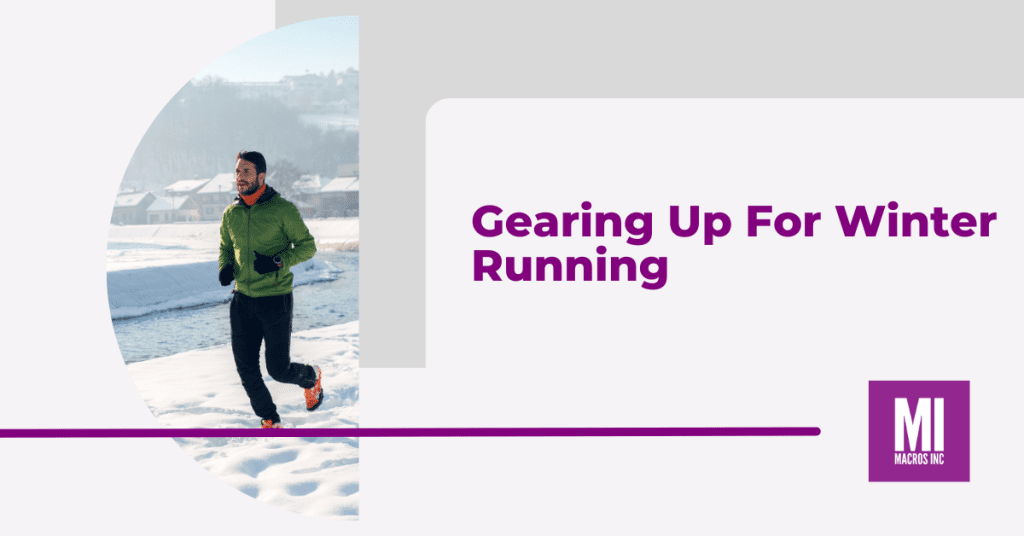Author: Ramona Moore | Macros Inc Coach
Running has seen a boom this year as we have dealt with gym closures and fitness class cancellations, which has led to people turning to outdoor running as a way to get exercise and relieve stress. So for many, this is will be the first cold season and the first taste of winter running you will experience. Or maybe you run seasonally and are not quite sure how to tackle running year-round. It may seem intimidating at first, but it is possible to continue your training through the winter and fly into spring a fitter runner!
Here is what you need to know to continue running through the winter season.
Jump to a Topic
Gear Up for The Right Temperature
To determine the appropriate clothing for winter running, a general rule of thumb is to dress as if it were 10-20 degrees Fahrenheit (5-10 degrees Celsius) warmer than the actual temperature. This helps prevent overheating while ensuring you stay warm throughout your run.
However, several factors can influence your clothing needs:
Factors That Determine What Winter Running Gear You Need
Your pace: You will generate more body heat running at faster paces so you will not need quite as much clothing if you are racing a 5k or doing a fast workout compared to an easy, slower paced run. (1)
Sunlight: If the sun is shining, it can feel warmer than if it is cloudy or dark outside.
Wind: The windchill effect applies to running too! When the wind is at your back, it will feel warmer than when you are running into the wind. If you can choose your route, it is best to avoid running into the wind when you are already sweaty.
Your temperature tolerance and preference: If you are normally cold or like to feel warmer while you are running, you can opt for the 20 degrees warmer rule of thumb and vice versa if you like to feel cooler.
Essential Winter Running Clothing
To help you stay warm without sacrificing mobility, consider these clothing basics when deciding what to wear running in winter.
Moisture-Wicking Base Layer: Start with a moisture-wicking base layer that will keep sweat away from your skin and prevent you from feeling clammy and chilled. Look for fabrics like merino wool or synthetic materials designed for moisture management.
Insulating Mid-Layer: Add an insulating mid-layer to trap heat and provide additional warmth. Fleece jackets or thermal tops are excellent options to consider.
Weather-Resistant Outer Layer: Invest in a weather-resistant outer layer, such as a lightweight and breathable running jacket or a windbreaker. This layer will shield you from rain, snow, and wind, while still allowing moisture to escape.
Breathable Bottoms: Choose breathable bottoms, such as thermal tights or pants designed specifically for running. Look for materials that provide insulation while allowing for freedom of movement.
Accessories: Don’t forget to protect your extremities. Wear moisture-wicking socks, thermal gloves, a hat or headband to cover your ears, and a neck gaiter or scarf to protect your neck and face from the cold.
Other items you may need depending on the conditions:
- A neck gaiter or ski mask to protect your face on those really cold days
- Sunglasses to protect your eyes from the wind or glare off the snow
- A reflective or lighted vest and a headlamp if you do not have full daylight
- Hand warmers in your gloves
You will feel cold when you first step outside, but as you warm up, you should feel comfortable in what you are wearing. There are charts online that will help you mix and match your winter gear for your conditions but nothing beats trial and error to find what works best for YOU!
Considerations for Winter Running
The other major consideration for winter weather running is road or trail conditions. You will want to pay a little more attention to your footing and running surfaces. What looks like wet pavement could be ice, or ice could be hiding under leaves, snow or other debris.
Most likely you will be able to continue running with the same shoes you wear in the summer, provided they have enough traction to grip the road or trail if it is a little slick. Some runners will add traction cleats like Yaktrax to their shoes if they know they will be facing more slippery conditions.
Can It Be Too Cold for Winter Running?
There are situations where it can be too cold to run outside. For example, if you have a health condition that is affected by cold or dry air or there is a risk of frostbite, be sure to watch your local weather warnings and reschedule your run or stick to the treadmill if it will not be safe for you to be outdoors.
Some of my favorite runs have been during the winter, especially after a fresh snowfall and it really can be an enjoyable time of year to run. So whether you are a new or veteran runner, give your gear a check and make sure you are ready to get out there this winter! Future you will be glad you did.
Try our nutrition coaching, for free!
Be the next success story. Over 30,000 have trusted Macros Inc to transform their health.
Simply fill out the form below to start your 14-day risk-free journey. Let's achieve your goals together!


